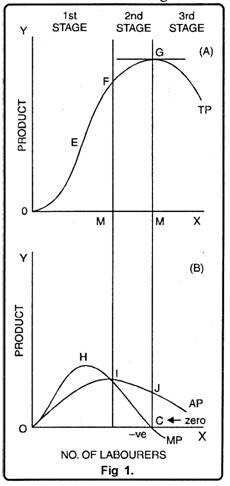LAW OF VARIABLE PROPORTIONS
Law of Variable Proportions states that the use of more and more units of variable factor of production along with specific number of units of fixed factor results in changes in total product in variable proportions.
ACCORDING TO LEFTWITCH
“The law of variable proportions states that if the input of one of the resources is increased by equal increments per unit of time while the inputs of other resources are held constant, total output will increase, but beyond some point the resulting output increase will become smaller and smaller.
ACCORDING TO P.A. SAMUELSON
“An increase in some inputs relative to other fixed inputs will, in a given state of technology, cause output to increase, but after a point the extra output resulting from the same additions of extra inputs will become less and less.”
ACCORDING TO STIGLER
“As equal increments of one input are added, the inputs of other productive services being held constant, beyond a certain point the resulting increments of product will decrease, so the marginal product will be diminishing.”
Thus, the law of variable proportions states that as the proportion between fixed factor and variable factors is changed, the total production at first increases more than proportionately, then proportionately and finally less than proportionately.
ASSUMPTIONS OF THE LAW
NO CHANGE IN THE TECHNIQUE OF PRODUCTION
This law assumes that there is no change in the technique of the production. Because whenever there is any change or improvement in the technique of production, more output can be produced with the use of as much resources as were being used before.
NATURE OF FACTORS OF PRODUCTION
The law of variable proportions is based on the assumption that there are only two factors of production. One factor is fixed and another is variable.
HOMOGENEOUS UNITS OF FACTORS OF PRODUCTION
It is also assumed that the units of factors of production are homogeneous i.e. all the units are the same.
APPLICABLE IN SHORT RUN
The law of variable proportions is applicable in short run only. Because only in the short run one factor can be kept constant as in the long run all factors are variable.
POSSIBILITY OF USE OF VARYING FACTORS OF PRODUCTION
Under this law, there is great possibility that the variable factors are applied in varying proportions. Because of this assumption, it is possible to use more and more units of variable factor of production with the given number of units of fixed factor so that output may be increased.
EXPLANATION OF THE LAW OF VARIABLE PROPORTIONS
The law of variable proportions can be explained with the help of following table in which the Land is taken as the fixed factor of production and Labour is taken as the variable factor of production.
| UNITS OF LAND | UNITS OF LABOUR | TOTAL PRODUCT | AVERAGE PRODUCT | MARGINAL PRODUCT | DESCRIPTON |
| 10 10 10 | 1 2 3 | 20 50 90 | 20 25 30 | 20 30 40 | FIRST STAGE Stage of Increasing returns: TP increases at increasing rate, MP & AP also increasing. |
| 10 10 10 10 | 4 5 6 7 | 120 140 150 150 | 30 28 25 21.4 | 30 20 10 0 | SECOND STAGE Stage of Diminishing Returns TP increases at decreasing rate, MP & AP decreases, MP becomes zero. |
| 10 | 8 | 140 | 17.5 | -10 | THIRD STAGE Stage of Negative Returns TP & AP falls, MP becomes negative. |
This law can also be explained with the help of following diagram:

FIRST STAGE OF PRODUCTION
In this stage:
- Total product increases at increasing rate as more variable factors are applied with fixed factors.
- Average Product also increases at a speed less than Marginal Product.
- Marginal Product increases at a speed greater than increase in Average Product.
SECOND STAGE OF PRODUCTION
In this stage:
- Total product increases at diminishing rate and become maximum or highest.
- Both Average Product and Marginal product falls but fall in MP is greater than fall in AP.
- MP also reaches the level zero.
THIRD STAGE OF PRODUCTION
In this stage:
- Total Product starts to decline.
- AP falls but remains positive.
- MP becomes negative.
STAGE OF RATIONAL DECISION MAKING
Second stage of production is the rational stage of decision making. In this stage TP is increasing at diminishing rate. Both AP and MP are declining but they are positive. The profit maximising output and employment lies in this stage of production.
